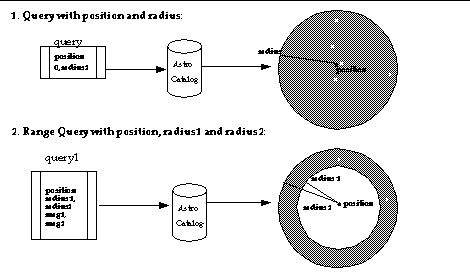Each type of astronomical catalog may contain a different set of columns. At least one of the columns should contain a unique id that can be used to identify the object. Catalogs that support world coordinates should have the columns RA and DEC in decimal degrees or H:M:S D:M:S .
|
an HTTP URL pointing to more info on the object, such as can be displayed in a web browser (netscape) |
|
|
an HTTP URL pointing to an image of the object (DSS or HST, for example) |
By default, the first 3 columns are assumed to be ID , RA and DEC. The column positions can be overridden in the catalog configuration file.
Not all catalogs support World Coordinates. Some may have the position specified in image pixel coordinates. These catalogs are also supported, but require a special entry in the catalog configuration file indicating the positions of the X and Y columns .
A catalog is not required to have any position columns. If the catalog contains neither world nor image coordinates, the catalog configuration file entry should indicate this by specifying a value of -1 for the column indixes of ra, dec, x and y.
There may be any number of other columns. Certain column names, such as More and Preview , are taken to have special meanings by some applications (such as Skycat).
One of the most common operations on catalogs is a circular search, which returns a list of objects within a given radius range of a center position.
In addition to the above attributes, that apply to any catalog having position coordinates, it may be possible to search for a range of values for any of the other catalog columns. This depends on the way the catalog server is implemented. An entry in the catalog configuration file specifies a list of search columns for each catalog.
A simple catalog query might specify a name or world coordinates position and a radius and get as a result a list of all of the objects in the given circle. A more complicated query would specify a minimum and maximum radius, and perhaps a minimum and maximum magnitude.

In each query, only the non-null fields are considered. A special null position is defined by library interface. Note that not all types of queries are supported by all catalog servers.



Please send questions or comments to abrighto@eso.org@eso.org.
Copyright © 1998 ESO - European Southern Observatory